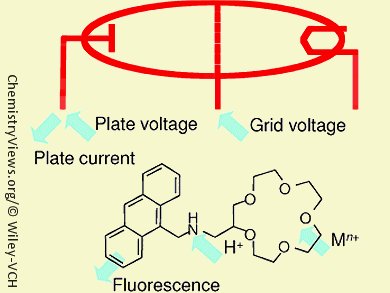Using Logic
For many years, Prasanna de Silva and colleagues, Queen’s University, Belfast, UK, have been thinking logically, working with sophisticated molecular schemes that replicate the behavior of the Boolean logic gates found in computational circuits. They have built the AND, NOT, NOR, XOR units that are usually tailored in etched semiconductor materials on the silicon chips found in every PC, tablet computer, and smart phone. They have had many successes in a quarter of a century of effort and while the molecular computer remains a distant option, their logic units and arrays of these devices have found applications in sensors with great potential in medical diagnostics and environmental analysis. Indeed, some of these medical diagnostics devices have sales of over $110 million to date.
The First Photo-ionic Version of a Triode
Now, the team has taken a trip down the proverbial “memory lane” [pardon the pun] to replicate the behavior of one of the building blocks of the logic gates used before the invention of the transistor and the silicon chip – the triode. Triodes first demonstrated in 1906 by Lee De Forest built on the pioneering work of the nineteenth century in electricity and magnetism and essentially laid the foundations for modern electronics. The device looking, to modern eyes, like a steam punk gadget is essentially a glass bulb, from which the air has been excluded bearing three electrodes: a heated filament or cathode, a grid, and a plate, the anode. It acts as an amplifier modulating a weak electrical trickle into a strong signal that could then be used to send radio signals or power the telegraph. The modern transistor is the “solid state” analogue of the triode avoiding the vacuum bulb and the heating element and replacing them with semiconductor components that nevertheless take a weak input and amplify it.
Given the legacy of the triode it was almost an obligation that de Silva’s team should turn to creating a molecular version of this crucial component of early electronics. Moreover, they have now demonstrated the first photoionic version of a triode. “Photoionic devices employ light and ions to communicate with the outside world,” de Silva told ChemistryViews.org. “Photoionic devices formed the first molecular logic gates and still form the majority of the available examples.”
Three Molecular Active Components
The researchers have replicated the thermionic triode, the valve, by using three active components: a fluorophore (an anthracene) unit with various side chains, a receptor for protons (an amine group), and a receptor (a crown ether) for a second ion, Na+, for example. The team synthesized their molecular triode from 9-anthraldehyde by conversion into an imine with aminomethyl-[15]crown-5 ether, which they then reduced with sodium borohydride to give them a fluorescent PET sensor for protons with an important additional tuning element. These components are thus analogous to the filament, plate, and grid in a conventional triode. The input–output profile is tunable in the molecule and the valve with the aid of the third component.
De Silva points out that photo-ionic devices can now emulate a wide range of computing devices, from the smallest component (a triode) to rather large logic gate arrays [1]. “The photoionic version of a tunable input–output profile triode plugs a gap in computing device emulation by molecules,” says de Silva. “Secondly, the tuning of a pH-dependent fluorescence profile by addition of a salt gives a new way of thinking to optimize a pH sensor to measure fluctuations about a normal pH value of a patient, for instance.” The next step will be to change the sensor components so that rather than monitoring sodium concentration-dependent pH values, other pairs of ions might be observed, citrate versus calcium ions, for instance, in blood electrolyte diagnostics and other areas.
Beyond the Basic Boolean Operations
Alberto Credi, Photochemical Nanosciences Laboratory, Università di Bologna, Italy, describes the work as both interesting and creative. “The interpretation of the behavior of this PET molecule in terms of a vacuum triode is another conceptual step forward towards the development of chemical species capable of transforming inputs into outputs according to predetermined functions of varying complexity,” he told ChemistryViews.org. “This goes well beyond the basic Boolean operations that were the object of de Silva’s and others’ earlier studies.” He suggests that the utilization of such a sensor in a complex biological matrix, such as blood serum, which contains a variety of electrolytes, would require complicated calibration procedures. “Nevertheless, owing to the modular design strategy and the structural simplicity of the compounds (which means easy synthesis), this approach can be utilized for targeting diverse problems in analytical chemistry,” he adds.
- Modification of Fluorescent Photoinduced Electron Transfer (PET)Sensors/Switches To Produce Molecular Photo-Ionic Triode Action,
Allen J. M. Huxley, Marc Schroeder, H. Q. Nimal Gunaratne, A. Prasanna de Silva,
Angew. Chem. Int. Ed. 2014,
DOI: 10.1002/anie.201310939
[1] A Prasanna de Silva, Molecular Logic-based Computation, Royal Society of Chemistry (RSC), Cambridge, UK, 2012. ISBN: 978-1-84973-148-5




